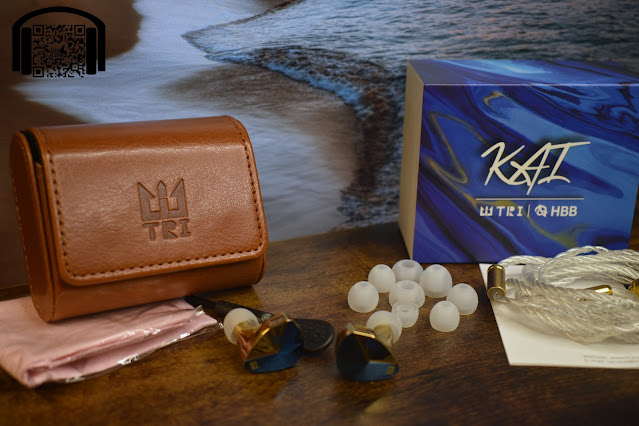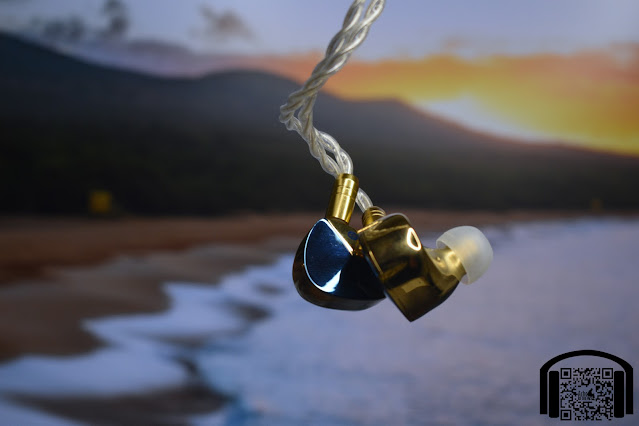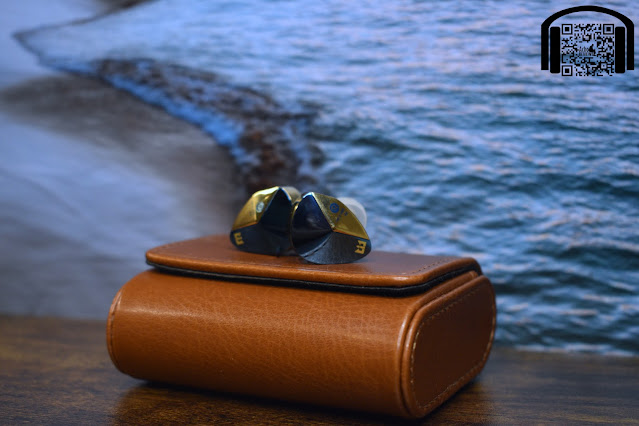- Get link
- X
- Other Apps
English | Español
Also available on YouTube in Spanish: Acho Reviews YouTube
The TRI x HBB KAI have been sent to me by KeepHifi in exchange for the publication of this review. There have been no specific requests, therefore, I will do my best to be as sincere and unbiased as possible, but it is always good to consider the fact that these IEMs have not actually cost me anything.
The KAI can be purchased via KeepHifi here: https://keephifi.com/products/tri-x-hbb-kai
(As always, the above link is non-affiliate).
Intro…
I think that at this point, most people in the IEM world have heard of HBB (Hawaiian Bad Boy), the person behind the YouTube channel, Bad Guy Good Audio Reviews. Apart from a large following of his reviews, he has increased his presence in recent times with quite a few collaborations. The TRI x HBB KAI is another of these collaborations and if I remember correctly (someone will certainly let me know if I don’t), it is his first collaboration with TRI and it is also the first single dynamic driver offering by the brand.
Strangely enough, while I have consumed a lot of content by HBB over the years, and discussed a few things, I have never actually tried any of his collaborations (unless we count the KZ fiasco, which I am not going to).
There really isn’t a specific reason behind not trying out his collabs, the ocasion just didn’t arise. I actually got a feeling for HBB’s preferences quite some time ago, when comparing his opinion to mine on specific sets, and while we may not share the same tuning preferences (depending on the music), there is no doubt that his input to the IEM world has been quite notable, whether you like his style of doing so or not.
Anyways, as some of his collaborations are not only recommended time and time again in their price brackets, they are also models that I get asked about regularly, to which I always have to respond “sorry, I haven’t heard them”. I guess that is something I need to work on fixing, and the KAI is as good a place to start as any.
Presentation…
I have to start this section with praise for what is almost the perfect presentation for me personally. I don’t mean perfect because of what is or isn’t included, I mean the actual way things are packed.
Inside the products box, which is quite compact, we get the storage/travel case (which is the same size as the box). Inside this case are all the contents included with the KAI. That is, the IEMs, the cable, 6 sets of tips (wide and narrow bore), a cleaning tool and a microfiber cloth, along with the usual user manual etc.
For a set of IEMs that come in at around 80€, I really don’t think there is anything to complain about here, you have everything you could need to enjoy the IEMs. Yes, there are always “wishes” that some people would like to see (like specific tips, etc) but seriously, the contents are more than enough in my opinion.
And my praise for the way things are packed is because there isn’t a ton of packaging that needs to be thrown away (or thrown in a drawer). There are still plastics used for the small bags that contain the tips and microfibre cloth etc. but these are minimal and I feel that more manufacturers should take note.
Build and aesthetics…
I have to say that I am not someone who favours anything gold coloured (as I have mentioned in past reviews of gold items), I find that it just seems to make things look cheap. In the case of the KAI, while it is still not a colour scheme that I would pick personally, they actually don’t look too “tacky”. Combining a light gold colour with a light blue faceplate, overall aesthetics work well together and I can see many people liking them.
The build is all metal, seemingly well assembled (although time is the only true test as far as build quality), with the small text and logos on the faceplate being discrete enough to not stand out but also done well enough to stand up to close inspection.
The included cable is also of good quality, with hardware that matches the IEMs, and while nothing extraordinary, it is better than so many other cables that are included with other sets. Swapping out the cable is something that each person will decide for themselves but I honestly don’t see any need in this case.
Finally, the storage/travel case is also of good quality. It is of a style that is included with a few brands and works well. I have quite a few similar cases and I have absolutely no issues with it, it is more than adequate for a set of IEMs, regardless of their price.
Sound…
*As always, all tracks mentioned are clickable links that will allow you to reference the track in the streaming service of your choice
As I said in the intro, I don’t always share the tuning preferences of HBB but that depends a lot on what music we are referencing. I do listen to a lot of the same music that he does, although probably not as often, and from past references, his tuning does work well for a lot of that music (actually, it works well for all of that music, it is just personal preferences that change).
Where our tastes usually differ are in the midbass area, with HBB preferring more warmth in these regions. This extra warmth is something that I also enjoy a lot with genres like rock, where it works well to give the bass guitar and lower end of electric guitars a little more warmth and roundness, especially with some of the older 70’s and 80’s recordings.
But anyway, let’s get on with it, here is the comparison of the KAI against my own personal preference. Let me say again, something that I have repeated in many of my reviews, that the preference target is just a guide, I don’t need things to stick to the target to enjoy them, and I also don’t always enjoy sets that do stick to it.
Starting off with the lowest frequencies, as I usually do, there is plenty of extension and rumble down there. It is also presented in a way that keeps things fairly clean and defined. I find that there is more than enough to enjoy things like “Royals”, or to make a decent job of my usual “Chameleon” test track.
Moving into the mid bass, the presence does reduce as we move through them towards the bottom end of the mids. Although there is more midbass (and subbass) than I would usually pick, I must say that I am a fan of this style of tuning, where the amount ramps up the lower we go. This is something that I find works very well to keep the low end impressive but non-invasive in regards to the mids.
There is enough midbass to give classic rock some warmth (such as “Whole Lotta Love”, to name a track from my test list), make the low hits of hip-hop impressive and yet not get in the way with more relaxed acoustical tracks.
I don’t think that details are the strong part of the KAI, even in the lower ranges, yet I really can’t fault the tuning at all in these low ranges.
Moving into the mids, there is no real sense of anything being pushed back, with things like the fretless bass of “Diamonds on the Soles of her Shoes” (which is highly dependent on those mid frequencies) being present enough to easily appreciate the great bass playing of Bakithi Kumalo.
As the mids start climbing towards their higher frequencies, the ramp up to bring vocals (and other mid centric instruments) starts to appear quite early yet it is not overdone. In fact, the KAI has the upper mids tuning that I said I would have liked the D13 to have, in other words, they aren’t as exaggerated as the D13 and don’t fall away as quickly, bringing vocals forwards without making them seem harsh.
Another positive is that they start to drop off before hitting my dreaded 5kHz range, although, with the ramp and presence between 1kHz and 4kHz, I probably wouldn’t have found the 5kHz mark too irritating even if the presence had extended a little further. However, as they ramp down before then, it’s a mute point anyway.
Moving into the higher frequencies, the KAI do roll away quite a bit, as is the case with so many single dynamic driver sets. While I would like a bit more in these upper ranges, I find that it does work well with the overall tuning, making the KAI more of a fun listening set than something you would pick to focus on details and nuances.
To be honest, I feel that the details are the weakest point of the KAI. Not that they are terrible, far from it, but they are not a highly detailed set of IEMs either. But, again, this does work in favour of the general vibe that they are aiming for (in my opinion of course). I am not saying that I wouldn’t have preferred more detail from these IEMs, I am saying that they way they present music does not put the focus on detail, so it is not something that is missed too much.
The isolation of the KAI is also pretty good, better than the average, meaning that, together with their additional bass presence, they do make for a good set to use while on public transport or just out and about in general.
Conclusion…
As I said at the start of this review, this is the first HBB tuning that I have listened to and I must say it’s pretty darn good. These are certainly IEMs that are focused on having fun listening to music and not sitting down to dissect the nuances of the reverb in the background of “All Your Love” (not that dissecting music isn’t fun also, depending on personal preferences).
They are not a tuning that I would personally pick as my daily driver but that is due to my personal preferences and not because these IEMs do anything wrong. In fact, they do a very good job of what they are aimed at, without even taking into consideration price to performance. Yes, there are things that can be improved upon, no doubt at much higher cost, but I think that these are something that most people could just pick up and enjoy.
I hope to try out a few more of the HBB collabs in the near future and if the KAI are anything to go by, then I’m sure I will enjoy reviewing them.
All FR measurements of IEMs can be viewed and compared on achoreviews.squig.link
All isolation measurements of IEMs can be found on achoreviews.squig.link/isolation
To comment or contact, visit any of the following social media platforms:





.png)
.png)

